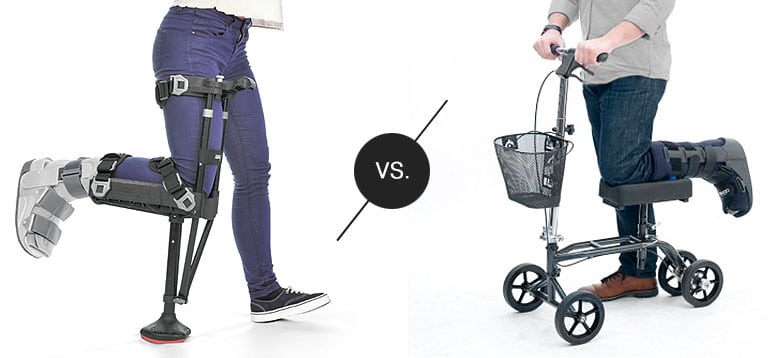The iWALK hands-free crutch is a more mobile and versatile alternative to a knee scooter, making it a better solution for many patients. Introduction (125 words): When it comes to recovering from a below the knee injury or surgery, finding the right mobility device can make all the difference.
Two popular options are the iWALK hands-free crutch and the knee scooter. While both provide a non-weight bearing solution, the iWALK hands-free crutch offers greater mobility and freedom. With the iWALK, users can walk easily and maintain their daily activities without the restriction of a scooter.
Unlike a knee scooter, the iWALK allows users to navigate stairs, small spaces, and maneuver easily. Additionally, the iWALK is more comfortable and provides better balance compared to a knee scooter. Overall, the iWALK hands-free crutch is a superior option for those seeking a more mobile and convenient recovery experience.
Pros And Cons Of Knee Scooter
The iWalk offers more mobility and freedom compared to a knee scooter. While both require kneeling on the shin, the iWalk provides better balance and a wider range of movement.
Fitting
One of the advantages of using a knee scooter is its adjustable design, allowing for a customized fit to meet individual needs. Most knee scooters have adjustable handlebars and knee platforms, ensuring that users of different heights can find their optimal position. This feature not only provides comfort but also promotes proper posture and weight distribution, which is crucial during the recovery process.
Knee Scooter Tips
Getting used to maneuvering a knee scooter may require some practice and adjustment. It is important to maintain a balanced and steady position while operating the scooter. It is recommended to start in a wide-open area with no obstacles to become familiar with the scooter’s turning radius and operation. Additionally, it is essential to wear appropriate footwear for stability and to ensure a firm grip on the knee platform.
Knee Pressure Issue
While knee scooters offer an alternative to crutches that puts less strain on the upper body, it is important to be aware of the potential pressure and discomfort on the knee. Prolonged use of a knee scooter can lead to knee fatigue and pressure sores. To alleviate this issue, it is advised to take regular breaks, elevate the injured leg, and use cushioning or padding on the knee platform for added comfort.
Turning Radius
The turning radius of a knee scooter is an important factor to consider when choosing between different models. A smaller turning radius allows for easier maneuverability in tight spaces and crowded areas. This can be particularly beneficial for individuals who need to navigate through narrow hallways, doorways, or crowded public spaces during their recovery period. It is recommended to look for knee scooters with a tight turning radius for enhanced mobility.
Compression Brakes
Compression brakes are an essential feature of a knee scooter that adds an extra level of safety. These brakes allow users to easily control their speed and come to a complete stop when necessary. By compressing the brakes, users can safely navigate inclines, ramps, and uneven surfaces. Having reliable compression brakes ensures a smooth and secure ride, reducing the risk of accidents and potential injuries.
Pros And Cons Of Iwalk
What is non-weight bearing?
Non-weight bearing refers to the restriction of putting any weight on a specific body part, such as the leg, during a recovery period after surgery or injury. It is crucial to follow this restriction to promote healing and prevent further damage.
The iWalk offers a significant advantage in terms of mobility and freedom compared to crutches or knee scooters. Unlike crutches that require the use of hands and offer limited stability, the iWalk is a hands-free device that allows users to navigate their surroundings more easily. It provides a more natural walking experience, allowing users to engage in daily activities with minimal restrictions.
The iWalk is suitable for below knee (BK) amputees, providing them with an alternative to traditional crutches or knee scooters. However, it is important to note that the iWalk is not suitable for leg amputees. Additionally, while the iWalk can be worn while sitting, it is not recommended for use while driving a car or riding in the passenger seat.
Overall, the iWalk offers several benefits, including improved mobility, freedom, and suitability for BK amputees. However, it is important to consider individual circumstances and consult with a healthcare professional to determine the most suitable mobility aid for a specific recovery period.
Comparison Between Knee Scooter And Iwalk
The decision between using a Knee Scooter or an iWalk for mobility during recovery can be difficult. Both devices offer advantages and it’s important to consider factors such as mobility, ease of use, comfort, stability, and cost. Let’s take a closer look at the key differences between these two options.
Mobility
When it comes to mobility, Knee Scooters and iWalk both provide effective solutions for those recovering from below the knee injuries or surgeries. However, their mechanisms differ. Knee Scooters are essentially four-wheeled devices that allow users to rest their injured leg on a padded platform while propelling themselves forward with their other leg. On the other hand, the iWalk provides hands-free mobility by strapping the injured leg to a crutch-like device that allows users to walk naturally, using their unaffected leg and hands for support.
Ease Of Use
In terms of ease of use, the iWalk tends to have a steeper learning curve initially, as it requires users to adjust to the new way of walking with their hands-free. However, once users become accustomed to using the iWalk, it offers greater maneuverability and the ability to navigate narrow spaces that can be challenging with a Knee Scooter. Knee Scooters, on the other hand, are generally easier to learn how to use right away, as they provide a similar movement to walking.
Comfort
Both Knee Scooters and iWalk can provide comfort during recovery, but this can vary depending on individual preferences and needs. Knee Scooters usually come with cushioned knee pads and adjustable handlebars, allowing users to customize their comfort levels. On the other hand, the iWalk offers a more natural posture and distributes weight evenly between the hands and unaffected leg, which can be preferable for some users.
Stability
In terms of stability, both Knee Scooters and iWalk have their own advantages. Knee Scooters provide a stable base with four wheels, which can give users a sense of security and balance. However, uneven terrain or tight spaces can pose challenges for Knee Scooter maneuverability. Meanwhile, the iWalk offers a higher level of stability during outdoor activities or on challenging terrain, as users can rely on their hands and unaffected leg for support and balance.
Cost
When considering cost, Knee Scooters are generally more affordable compared to iWalks. Knee Scooters usually have a lower upfront cost, and they are readily available for purchase or rental options. On the other hand, iWalks tend to be more expensive due to their specialized design and hands-free functionality. Additionally, iWalks may require additional accessories or replacement parts over time, which can add to the overall cost.
In conclusion, the choice between a Knee Scooter and an iWalk depends on individual preferences, needs, and the specific circumstances of the injury or surgery. Both devices offer unique advantages in terms of mobility, ease of use, comfort, stability, and cost. It’s important to evaluate these factors to determine which option is best suited for your recovery journey.
Frequently Asked Questions For Iwalk Vs Knee Scooter
Which Is Better Knee Crutch Or Scooter?
The iWalk knee crutch is better than a knee scooter because it offers greater mobility and freedom. It is a hands-free solution that allows for more comfortable movement during recovery from below the knee injury or surgery. The knee scooter may provide a safe and easy-to-maneuver alternative to crutches, but the iWalk offers additional benefits for patients.
Can You Sit Down With An Iwalk?
The iWalk can be worn while sitting, but not while driving or riding in a car. It is suitable for below knee (BK) amputees but not for leg amputees. It offers mobility and freedom similar to a knee scooter.
What Is The Difference Between A Knee Walker And A Knee Scooter?
A knee walker and a knee scooter are the same thing. They are both medical mobility devices used as an alternative to crutches for those recovering from below the knee injury or surgery. They provide a safe and comfortable way to move around without putting weight on the foot or leg.
The terms “knee walker” and “knee scooter” are interchangeable.
What Is The Difference Between The Freedom Leg And The Iwalk Free?
The main difference between the Freedom Leg and the iWalk Free is the design of the bottom part. The Freedom Leg has a wide squared edge bar, providing better lateral balance. On the other hand, the iWalk Free has a rounded foot, which may not provide the same level of stability.
Conclusion
Considering their unique features and benefits, it is clear that the iWALK hands-free crutch surpasses the knee scooter in terms of mobility and convenience. With greater maneuverability and the ability to use your hands freely, the iWALK offers a more comfortable and efficient alternative for those recovering from below the knee injuries or surgeries.
Its versatility makes it a better choice for patients seeking a more independent and mobile lifestyle during their recovery process. Say goodbye to the limitations of traditional crutches and embrace the freedom that the iWALK hands-free crutch provides.

